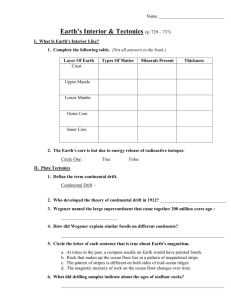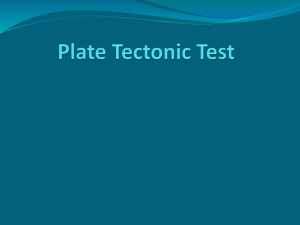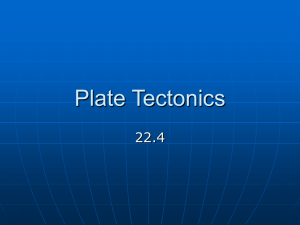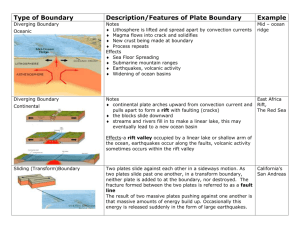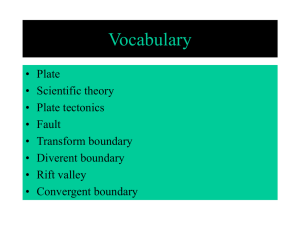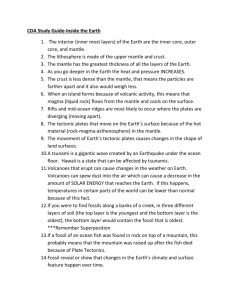Plate Tectonics Review Answers
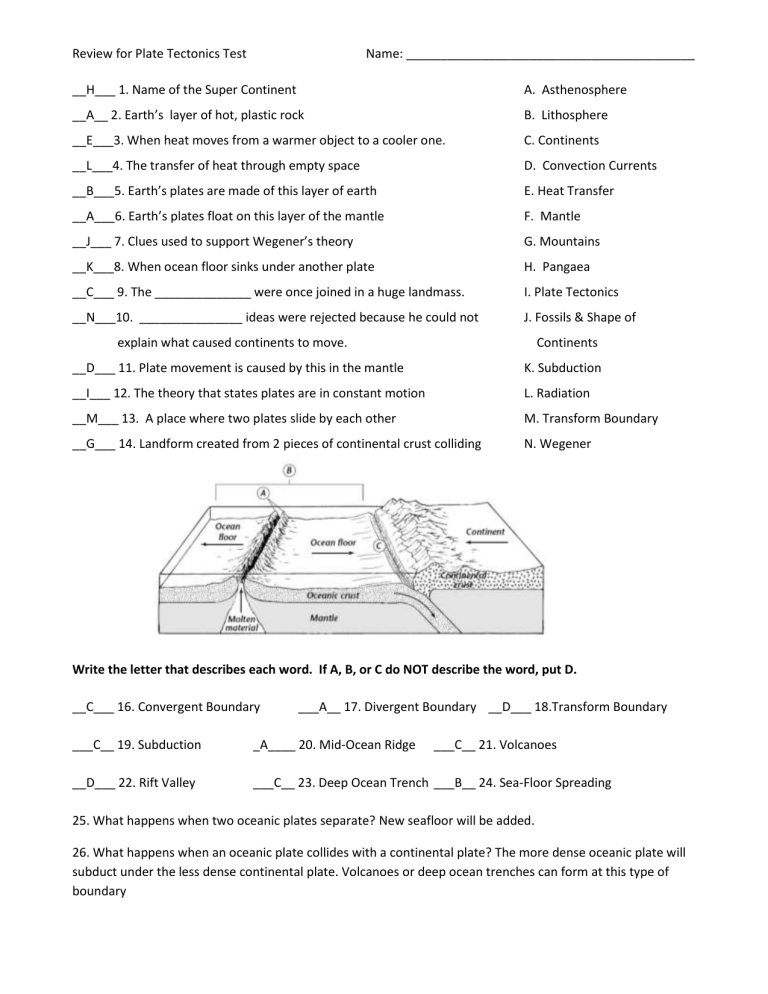
Review for Plate Tectonics Test Name: __________________________________________
__H___ 1. Name of the Super Continent
__A__ 2. Earth’s layer of hot, plastic rock
__E___3. When heat moves from a warmer object to a cooler one.
__L___4. The transfer of heat through empty space
__B___5. Earth’s plates are made of this layer of earth
__A___6. Earth’s plates float on this layer of the mantle
__J___ 7. Clues used to support Wegener’s theory
__K___8. When ocean floor sinks under another plate
__C___ 9. The ______________ were once joined in a huge landmass.
__N___10. _______________ ideas were rejected because he could not explain what caused continents to move.
__D___ 11. Plate movement is caused by this in the mantle
__I___ 12. The theory that states plates are in constant motion
__M___ 13. A place where two plates slide by each other
__G___ 14. Landform created from 2 pieces of continental crust colliding
A. Asthenosphere
B. Lithosphere
C. Continents
D. Convection Currents
E. Heat Transfer
F. Mantle
G. Mountains
H. Pangaea
I. Plate Tectonics
J. Fossils & Shape of
Continents
K. Subduction
L. Radiation
M. Transform Boundary
N. Wegener
Write the letter that describes each word. If A, B, or C do NOT describe the word, put D.
__C___ 16. Convergent Boundary
___C__ 19. Subduction
___A__ 17. Divergent Boundary __D___ 18.Transform Boundary
_A____ 20. Mid-Ocean Ridge ___C__ 21. Volcanoes
__D___ 22. Rift Valley ___C__ 23. Deep Ocean Trench ___B__ 24. Sea-Floor Spreading
25. What happens when two oceanic plates separate? New seafloor will be added.
26. What happens when an oceanic plate collides with a continental plate? The more dense oceanic plate will subduct under the less dense continental plate. Volcanoes or deep ocean trenches can form at this type of boundary
Review for Plate Tectonics Test Name: __________________________________________
27. How do convection currents in the Earth work?
The hotter, less dense material in the asthenosphere rises and the cooler, more dense material sinks This pattern of movement causes the plates to move since the tectonics plates are on top of the asthenosphere.
Use the figure above to answer the following questions.
28. What feature of the ocean floor is shown at A?
Mid-ocean ridge
29. Describe the process shown occurring at B, and explain what results from this.
New sea floor is being added through the process of sea floor spreading. New crust is added to the ocean floor and is eventually recycled back into the mantle at the deep ocean trench.
30. What happens to old oceanic crust as new molten material rises from the mantle?
It is recycled back into the mantle through the process of subduction. The process of subduction also plays a role in the new molten material rising from the mantle (see page 132).
31. The arrows on the figure show the ocean floor spreading from the ridge. What are three kinds of evidence scientists have found to support this idea?
1. Age of the rock from the sea floor
2. Shape of the rock (pillow shaped)
3. Magnetic striping in the rock
Review for Plate Tectonics Test Name: __________________________________________
32. What process is shown occurring at C, and why does it occur?
Subduction. The more dense oceanic plate subducts beneath the less dense continental plate
33. Where would you expect to find the oldest rock on the ocean floor?
Near a deep ocean trench (point C on the diagram)
Fill in the blank to complete each statement.
34. Scientists use ____Sonar___________________ to map the ocean floor.
35. The feature on the ocean floor at C is called a(n) ______deep__ocean trench__________________.
36. The process that continually adds new material to the ocean floor is called ______sea-floor spreading. __.
37. The process by which the ocean floor sinks into the mantle is called ____subduction_________________.
38. The chain of mountains that extends into all of Earth’s oceans is the ______mid-ocean ridge____________.
Essay:
Choose one of the landforms below to completely analyze. Each has a letter that matches up with its corresponding boundary on the map on the next page. Make sure that you:
Identify what type of boundary it is and the movement that is occurring
Identify the plates that the boundary occurs between
What causes this boundary/plate movement
What the effects are at this boundary
Use specific location and names where necessary


